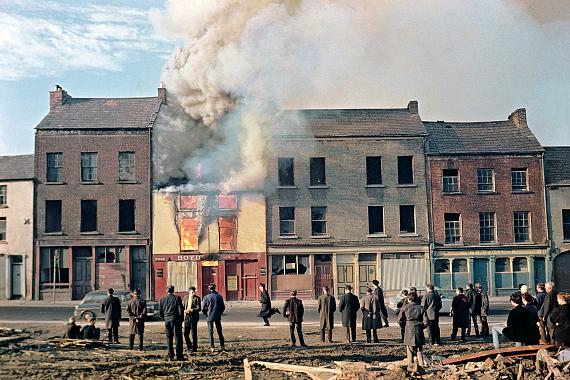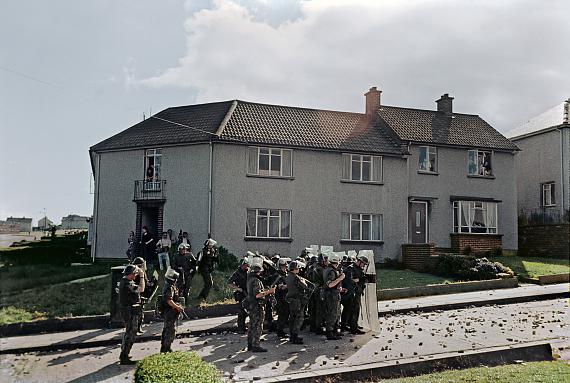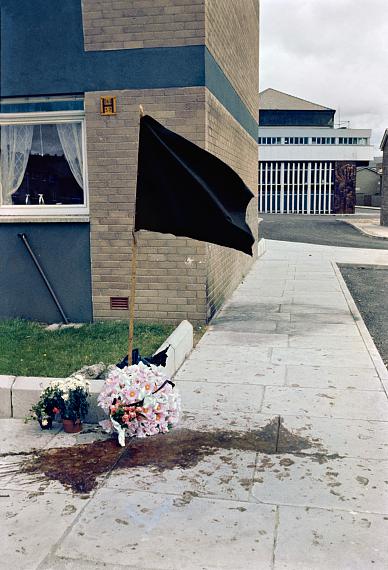
© Estate of Akihiko Okamura
Akihiko Okamura »
The Memories of Others
Exhibition: 11 Apr – 6 Jul 2024
Thu 11 Apr 18:00

PHOTO MUSEUM IRELAND
Meeting House Square
D02 X406 Dublin
+353 (0)1-6714654
info@photomuseumireland.ie
photomuseumireland.ie
Tue-Sat 11-17

1970s. Lundy was Governor of Derry reviled by Ulster loyalism as a traitor during
the Siege of Derry in 1688. An effigy of Lundy is burnt at the end of the annual
Apprentice Boys’ Parade in August in Derry.
© Estate of Akihiko Okamura
Akihiko Okamura
"The Memories of Others"
Exhibition: 11 April - 6 July 2024
Photo Museum Ireland is delighted to present the world premiere of The Memories of Others exhibition, photobook and film on the Irish work of Japanese photographer Akihiko Okamura.
From the late 1960s to the early 1980s, renowned Japanese war photographer Akihiko Okamura (1929-1985) created a remarkable, compelling and largely unseen body of work in Ireland, north and south. This exhibition also launches a major programme which include sa documentary film and the first publication on Okamura’s Irish work. After covering the Vietnam War, Akihiko Okamura went to Ireland in 1968 to visit the country of JFK’s ancestors. Soon after, in 1969, he decided to move to Ireland with his family. From then on, he continually photographed the Troubles in the North and his life with his family in the South, until he suddenly passed away, in 1985. His photographs of Ireland, which have barely been seen before, demonstrate a unique artistic vision. This uniqueness is partly because Okamura chose to live in Ireland: of all the international photographers active during those years, he was in this sense a singular case of absolute commitment to Irish and Northern Irish history. This fusion with his subject matter led him to create images which were innovative both in terms of his own practice and of the photographic representation of the Troubles. His profound, personal relationship with Ireland allowed him to develop a new method of documenting conflict: poetic and ethereal moments of peace in a time of war.
Unlike other representations of the North of Ireland at that time, Okamura’s photographs are almost all in colour. Made in the North as well as in the South of Ireland, his photographs broke from the photojournalistic tradition, creating a series of still lives and abstractions. Their gentle, muted palette operates in counterpoint to the violent situation in which they were produced; they are remarkably out of sync with the conventional, black-and-white, “heroic” photographic representations that have come to define this period. Okamura’s work reveals a more subjective perspective, often going beyond conventional photographic representations of riots, burning cars and bombed buildings, to capture quieter, intimate, quasi-surreal moments that reveal his empathetic concern for the communities he photographed. This intuitive narrative choice was intimately connected to the depth of his attachment to Ireland and the Irish people. While Okamura remains highly respected in Japan, his Irish work and experience, crucial to both his oeuvre and his personal life, had never been studied until now. The rediscovery of this archive constitutes a revelation both for the history of Japanese photography and Irish history.

© Estate of Akihiko Okamura
Akihiko Okamura was born in 1929 in Tokyo. He began training in medicine but dropped out, joining the editorial team at New Weekly in 1961. Assigned to a story in Bangkok, he turned to photography, going on to record international conflicts. He distinguished himself as a very important war photographer in Vietnam in the 1960s. There, he photographed, among others, the prisoners of war held by the Vietcong after he himself was held by them for 53 days. His work appeared in Life and other major publications at the time. Constantly striving to tell the story of conflicts and of human rights violations, Okamura’s photojournalism took him to conflict zones from Ethiopia to Biafra, and Northern Ireland. He cited his own "dark memory" of childhood terror in Tokyo under Second World War bombing attacks as the source of his urge to tell the story of conflicts through pictures. Akihiko Okamura settled in Ireland with his family in 1969 and lived there until he passed away in 1985.
Memories of Others photobook is published by acclaimed publishers Atelier EXB (co-published in English by Prestel), edited by Pauline Vermare and featuring essays by Pauline Vermare, Masako Toda, Seán O’Hagan and texts by Kusi Okamura and Trish Lambe accompanies the exhibition priced €58.
Film Premiere The Memories of Others: A new documentary film uncovering Akihiko Okamura’s extraordinary Irish work and the artistic and emotional impact of its recent rediscovery. Directed by Pauline Vermare and Marc Lesser. Produced by Lucky Tiger Productions, New York 2023, colour - 20 minutes duration.

Northern Ireland, c. 1970
© Estate of Akihiko Okamura

Beattie (19 years old) was shot and killed on 8 July 1971 by the British Army.
Seamus Cusack (28 years old) was shot dead near this spot about twelve hours later.
These men were the first people shot dead by the British Army in Derry.
© Estate of Akihiko Okamura